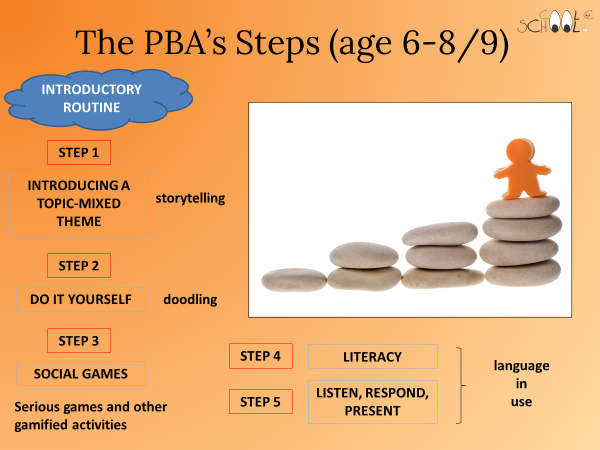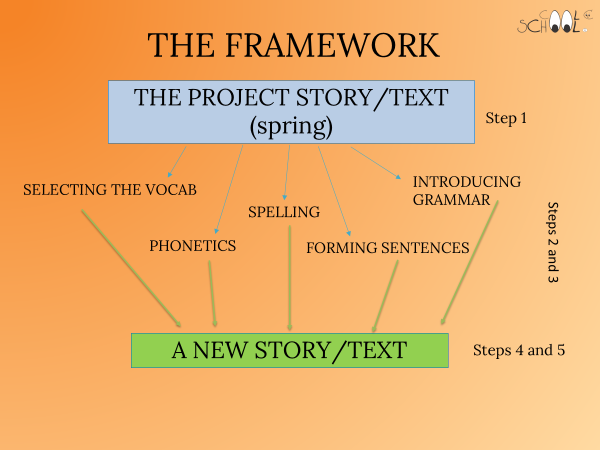The Project Based Approach (PBA) Framework
Mija Selič is a teacher, teacher trainer and the owner of C00lSch00l private language school. She is an innovator in finding new ways of teaching and in developing teaching materials for very young language learners. She has a master’s degree in primary teaching and a degree in English. She also holds a certificate in convergent pedagogy. She created online PBA courses for young foreign language learning and are available on website: https://c00lsch00l.thinkific.com/ , e-mail: mija.selic@gmail.com
What is the Project Based Approach (PBA)?
The Project Based Approach (PBA) is an approach with a given framework (a ‘how to do it’) in which the activities are organised in such a way as to support one another from both a language and a social perspective, bearing in mind the ‘big picture’ (the aims).
The framework is made up of Project Steps (Illustration 1), which systematically cover all language skills, focusing equally on communication and socialisation. The approach follows natural-like ways of correspondence wrapped in foreign language activities.

Introductory routine
The introductory routine is a set of warm-up activities with fixed aims executed at the beginning of every lesson. It can take up to twenty minutes or can be used as the entire lesson, depending on what we want to achieve. When children are first introduced to a new language, for the first couple of months, the entire lesson is devoted to the introductory routine, as it is focused primarily on developing the skills required for the group to be able to function.
The introductory routine has four parts (aims) and should be followed as listed:
1 – GREETING (or: Hi, let’s wake up.);
2 – SOCIALISATION (or: Who are we and how do we accept one another?);
3 – GETTING READY (or: Who can focus longer?);
4 – COMMUNICATION (or: What can you tell me with the words you know?).
Greeting
It is only natural that when meeting someone you say ‘hi’. It is only natural-like that every lesson should start with a greeting.
Saying ‘Hi!’ can be done in many different ways. Since we have a planned lesson and need to cover certain curriculum aims, we can greet one another while achieving some other aims as we go. We can therefore sing a song or play a short ‘greeting game’, saying ‘hi’ at the end of it.
In the PBA, whatever the way of greeting may be, we always modify it to activate the brain at the same time. An effective way is to combine greeting with a brain-gym-like activity. To include language, we can perform the activity while counting, ‘checking’ our body parts, scanning our clothing, etc. One such activity is Body Count (explained in later chapters). We count in a brain-gym-like manner and say (or sing) hello at the end.
Socialisation
We know that children can only learn when they feel secure, comfortable and accepted. When they enter the school for the first time, lost in a totally new environment with complete strangers, the first step in the learning process is to encourage the children to get to know one another, to accept one another for who they are and through this to learn who they themselves are. We need to create a safe and welcoming learning environment. We do not need a mother tongue to do this, it can easily be achieved by introducing a new language. One appropriate activity is the Clap Hello game (explained in later chapters; author: Peter Dyer), which encourages eye contact attention. Pass the Message On focuses on touch and Listening Discrimination (author: Božena Wambach), which awakens the senses, involves practising motor skills and establishes the feeling of setting personal space boundaries (both activities are explained in later chapters).
Socialisation plays a significant role in children’s confidence in speaking activities in general, because it teaches them how to be in control of their body in different emotional states.
Getting ready
If we want to complete a task successfully, be it reading, listening, writing or speaking, we need to be able to focus. Psychologist Mihaly Csikszentmihalyi’s famous investigations of ‘optimal experience’ have revealed that what makes an experience genuinely satisfying is a state of consciousness called flow. During flow, people typically experience deep enjoyment, creativity and a total involvement with life (The Psychology of Optimal Experience, 2008). To prepare the brain to be able to achieve a high state of performance, we use activities that train the mind to focus. Such activities are Body Shapes and We Will Rock You (explained in later chapters).
Communication
What good do the words do if we cannot use them for the essential purpose, communication? Communication can start non-verbally, if we have not learned any vocabulary yet, or can be a ‘review’ of the previous lessons through a Poster Presentation (explained in later chapters) or various short games (described in later chapters).
When children are at their first lessons in the English language and are still acclimatising to the new language, we can use games that are played in their mother language, but explained and guided in English. Children soon recognise the game and have no problem understanding it.
The PBA Framework
Children up to the of age twelve see the world as one big event (global understanding) with no clear borderlines of the specifics that organise this big event (grammar, vocabulary, spelling, pronunciation, etc.). If confronted with specifics, they do not know what to do with them. When teaching them topic-related vocabulary, such as animals, they become confused. All they can do with it is memorise and repeat it, like a parrot.
If we want to show (teach) children some of the specifics within a ‘big event’, we first need to establish the ‘event’, then divide it into specifics, learn those specifics, and finally use the specifics to show the children the new event again.
When we repeat it often enough, children can gradually see the specifics within the event on their own.
Let us place the above explanation in our language learning approach (Ill. 2).

Introducing the ‘big event’ means that we present a story, an event in which everything – vocabulary, grammar, emotions, social and motor skills, etc. – is mixed together into an interesting plot. We do this in Step 1 – Storytelling (explained in later chapters).
Step 2 – Do-it-yourself is the part where the children gradually, through an activity called Doodling (explained in later chapters), recreate the story and in so doing learn the different parts (specifics) with which the story is put together: vocabulary, pronunciation, spelling, plural, etc.
In Step 3 – Social Games, the children memorise these specifics through playing various games or engaging in game-like activities (elementary, social, cooperative; see the previous chapters), while at the same time practising social, communication and motor skills. The gap-fill approach to speaking (explained in later chapters) helps them with sentence structure.
Once the specifics (vocabulary, spelling, grammar, etc.) are memorised, we then show the children how these learnt specifics are used in a meaningful message, whether through listening and speaking (in Step 4) or reading and writing (in Step 5).
Things to remember
When teaching young children up to the age of twelve, no matter what the subject, we need to wrap all knowledge in a story or event that gives children the complete situation of the happenings. Only then can we delve into specifics, which are always taken from the presented story/event.
When showing them how the learnt specifics can be put back together into a new story/event, we show them how to use the specifics in a new way.
With its solid framework, the Project-Based Approach follows a project type of work and leaves the teacher a lot of flexibility regarding the themes they want to use, the grammar they want to cover or the games they want to play.
Please check the Pilgrims f2f courses at Pilgrims website.
Please check the Pilgrims online courses at Pilgrims website.
A Brief Practical Guide for L2 Teachers: K-2 American Children Learn Italian
Matteo Greco, ItalyThe Project Based Approach (PBA) Framework
Mija Selic, SloveniaEnglish as a Medium of Instruction (EMI): Developing Online and F2F Support Strategies at Verona University
Sharon Hartle, Italy;Geltrude Daniela Vescio, Italy;Mary Birkett, Italy;Massimo Marzio, ItalyExplicit Grammar Knowledge Development in EFL Adult Learners
William Godoy De La Rosa, Chile;Diego Monasterio, Chile